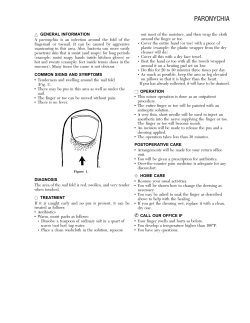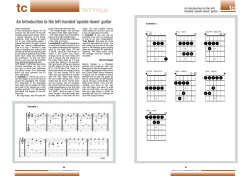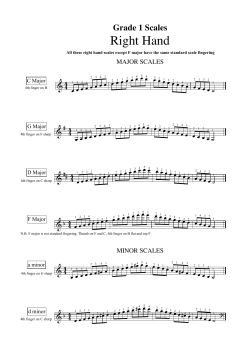
Mallet finger advice Emergency Department Information for patients
Emergency Department Mallet finger advice Information for patients This information leaflet is for people who have had a mallet finger injury. It describes the injury, symptoms and treatment. What is a mallet finger? A mallet finger is where the end joint of the finger bends towards the palm and cannot be straightened. This is usually caused by an injury to the end of the finger, tearing the tendon that straightens the finger. Sometimes a flake of bone may have been pulled off where the tendon should be attached to the end bone. An x-ray will show whether this has happened. In either case, without the use of this tendon the finger remains bent. What are the symptoms? • Pain • Swelling • Inability to straighten the tip of the finger How is it treated? Your finger will be placed in a plastic splint to keep your finger straight with the end joint slightly over extended (bent backwards). The splint must be worn both day and night for 6 to 8 weeks to allow the two ends of the torn tendon or bone to stay together and heal. The splint will be taped on, allowing you to bend the middle joint of your finger. The splint should only be removed for cleaning (see below). Although you can still use your finger, you should keep your hand elevated (raised) in a sling for most of the time until the doctor sees you in the outpatient clinic. This will help to reduce any swelling and pain. Pain relief You can take painkillers such as paracetamol. Please see the patient information leaflet that comes with the medicines and follow the instructions carefully. How to keep your finger and splint clean The splinted finger must be kept clean and dry at all times. If the skin becomes wet inside the splint it will become very sore. It is important to wash both your finger and the splint at least once a day. • Keeping your finger flat on the table, cut the strapping off the splint and slide the splint off your finger. • Wash and dry your finger and the splint using soap and water. Keep the end joint straight at all times by keeping the finger flat on the table. You may find it easier if someone helps you to do this each day, as any movement of the tip of the finger will delay healing of the bone or tendon and may even cause permanent damage. • Slide the splint back over the fingertip still keeping the finger straight. • Replace the strapping, which should cover the middle of the splint and should not cover the middle joint of the finger. Follow–up appointment We will give you an appointment for the next Hand Clinic. The Clinic is held on Tuesdays and Fridays in the Trauma outpatient department. If you have any questions or concerns, or if you need any further information, please contact them on: Tel: (01865) 222021 If you need an interpreter or need a document in another language, large print, Braille or audio version, please call 01865 221473. When we receive your call we may transfer you to an interpreter. This can take some time, so please be patient. Emergency Nurse Practitioner team Version 1, April 2009 Review date: April 2012 Oxford Radcliffe Hospitals NHS Trust Oxford OX3 9DU www.oxfordradcliffe.nhs.uk OMI 322.1
© Copyright 2025





















